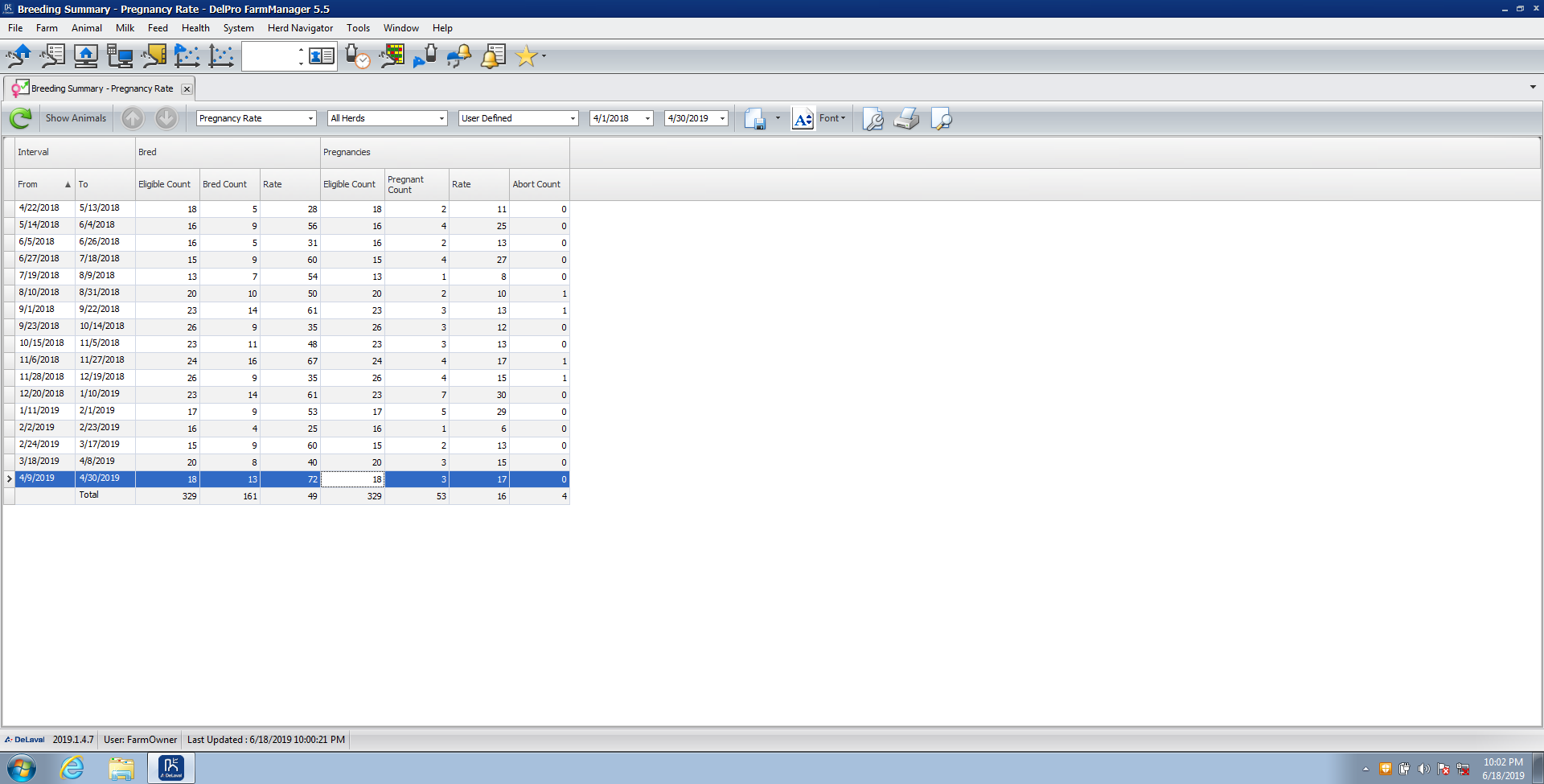Home
Learn
Inspired by DelPro™
Reproduction
Analyse your reproductive performance

How to analyse your reproductive performance in DelPro™ FarmManager
Our ultimate goal is to organize the breeding data for you to take reproduction management decisions based on reliable KPIs, and troubleshoot potential breeding success factors that can improve the efficiency of cows becoming pregnant. Within the menu Animal/ Herd Statistics/ Breeding Summary views, we present calculations of insemination and pregnancy rates (efficiency), and conception rate by different breeding factors (breeding success). In this, part 1, we focus on the analyses of pregnancy and insemination rates.

Pregnancy and insemination rate
Both the pregnancy rate (right side) and insemination rate (left side) are shown in the table in a 3-week interval; you will find it when selecting the Pregnancy Rate view. The start date and the finish date will be present on the first 2 columns on the left, and the period will include those days. For this calculation DelPro FarmManager takes a very specific sample of the herd, described as “at risk to become pregnant”, that’s why some consultants refer to this calculation as Pregnancy or Insemination Risk. This metric has been described as the single best tool for assessing both historical and ongoing reproductive efficiency in a dairy herd. The metric will estimate “speed” by calculating the rates for each 3-week cycle listed.

Eligible cows
For calculating each rate, DelPro FarmManager uses the number of eligible cows that were inseminated, or that became pregnant within the period, divided by the population at risk (or eligible cows) in the same period.
![]()
The Insemination rate, was formerly known as Heat Detection rate, because cows listed there were assumed to be found in heat and consequently bred. However, because Timed AI protocols (TAI) are becoming more widespread, the cows listed could be inseminated after natural heat expression, heat detection devices, or as a result of a TAI protocol. Hence, an exclusive Heat event record (without insemination), although rare, is not counted here.
It is important to understand the eligibility criteria. To be eligible, in both rates, we require that a cow:
- Is on her first lactation, or greater (no heifers included in the calculation)
- Passed the voluntary waiting period (VWP), which is specified in DelPro FarmManager - Farm Settings (reproduction settings) as “First Insemination Cows” (default value is 50). In other words, the cow has been defined of interest for becoming pregnant, from a management point of view. DelPro FarmManager will subtract 10 days from the VWP, allowing the inclusion of cows that will reach the requirement in the middle of the cycle.
- Is open or bred (i.e. not pregnant) at the beginning of the cycle. That means the cow could have a previous insemination without known result, never been bred, or had an open confirmation form a previous insemination.
- Is currently active in the system. In other words, has not been culled (exited) at the beginning of the cycle or has not been marked as “to be culled” in a future date.
Being eligible does not mean that the cow is actually cycling, or that the expected heat date is considered for inclusion. Remember that the metric is meant to include TAI cows as well. Additionally, the total count of eligible cows is not equal to the total open cows in the herd at any given time, and only represent a specific sample population. Likewise, the count of bred and pregnant cows in each cycle does not represent the total of such events in the specific period, since it only focuses on the eligible cows.
Cows that have had an abortion will be immediately eligible on the next cycle (on start date of the period). Although some cows may not be in the right condition after an abortion, the majority of pregnancy losses we see, occur soon after conception and are detected as a result of a heat shown by a previously pregnant cow (early embryonic death). The insemination and pregnancy rate keeps your focus on getting that cow pregnant again, as soon as possible. The VWP rule will apply in late abortions where the cow has started a new lactation.
In summary
For that specifically defined population of eligible cows, we measure the efficiency of the farm to inseminate, and get pregnant, as many eligible cows as possible every 3 weeks. The assumption here is that an average healthy cow should show an opportunity of becoming pregnant in the same 3-week interval.
The pregnancy rate is a result of the insemination rate and the conception rate, hence improving both will definitely increase the pregnancy rate. However, it is a rare scenario where both criteria are improved at the same time. Therefore, maintaining a high insemination rate, with a decent conception rate, is the most preferred strategy. It is a fact that the chances of getting cows pregnant, without inseminating them, is zero. On the opposite side, it is risky to only focus on the conception rate (success of breeding) without paying attention to the insemination rate (efficiency), because often the farm will end up breeding fewer cows in order to increase the conception rate, resulting in an lower than aimed for pregnancy-counts.
Note: Analyses here described are base for DelPro FarmManager 5.5. As we continue to update our platform, some difference can be found from this information in older versions.